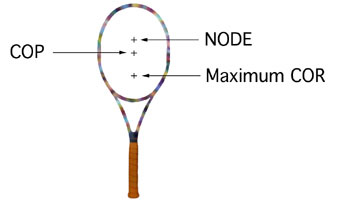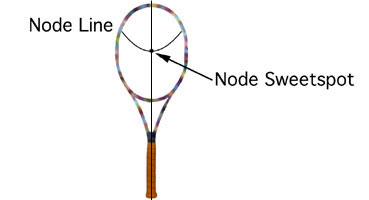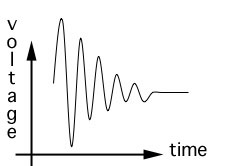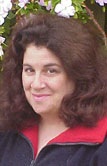February 2006 Article Tennis Server
|

 |
There were some questions on the Racquet Stiffness, Vibration and Dampening - Part 1 column regarding the "third" sweet spot, what an oscilloscope measures and interpretation of the oscilloscope patterns. Let me go back and resolve those questions first. Sweet Spots: Part 1's column noted that there are three sweet spots on a racquet. It discussed the center of percussion and the node of the first harmonic. These two sweet spots deal specifically with the subject of the column. When the ball hits the racquet both a sudden jarring shock and rapid fluctuating vibrations result. If the ball strikes the racquet's center of percussion that initial shock to the hand is minimized. If a ball strikes the node of the first harmonic, minimum vibration is felt by the hand and arm. The third sweet spot is the maximum coefficient of restitution (COR) where the ball rebounds with maximum power (and speed). While the sweet spot locations vary based on racquet length, weight, head size, balance and string tension, typically the sweet spots are relatively located as depicted in Figure 1.

Fig. 1 General Location Of The Three Sweet Spots Regarding the node of the first harmonic, it was noted that there is an area which forms a curved line from about the 2 o'clock to the 10 o'clock position on the racquet. If the ball strikes anywhere on the line the racquet does not vibrate. The sweet "spot" is the intersection of this curved line with the long axis of the racquet. If you hit the sweet spot, the racquet will not vibrate nor will it rotate and twist in your hand. If you hit the ball on the curved node line the racquet will not vibrate but it will rotate. The curved line and intersection (sweet spot) is depicted in Figure 2.

Fig. 2 Node Line Oscilloscopes: An oscilloscope is an electronic testing device that receives and graphically draws a two-dimensional representation of an electrical signal. The oscilloscope looks like a small television set and has a display screen with grid lines where the pattern is displayed and a probe that connects to the object to be studied. The horizontal axis (X) represents time and the vertical axis (Y) represents the voltage. Thus, the pattern you see on the oscilloscopes screen represents how the signal changes over time (Figure 3).

Fig. 3 Oscilloscope Signal Over Time Typically, a transducer is used with the oscilloscope. Specific transducers create an electrical signal in response to other physical input - sound, mechanical stress, heat, light, or pressure. While commonly used in the physics laboratory, oscilloscopes are used extensively in troubleshooting in the electronics as well as the automotive industries (for example, to measure engine vibrations). The transducer picks up the physical response and the oscilloscope displays this input as an electrical signal. Racquet Versus String Vibrations String Vibrations: There are a variety of "vibration damping or dampening" systems that are placed on the string bed. These do not reduce the frame shock or vibrations. These string vibration reduction systems do change the audible noise of the strings - typically described as changing the "ping" to a "thud." So the sound is different and for some players dampening the string vibrations enhances the comfort of the game. It is interesting to note that if two identical racquet frames have the same strings, the racquet with the lower string tension will have a lower pitch when the string is plucked. For the same strings and string tension, a racquet with a larger head will have a lower pitch. For two strings at the same tension, the longer string will have a lower frequency than a shorter string. This is because the frequency (F) varies as the inverse of the string length (L) [F ~ 1/L]
Racquet Frame Vibrations:
Cushion handles or grips use elastomers. The word "elastomer" is often used synonymously with the word "rubber." Rubber, Polyurethane rubber, buna rubber and Neoprene are all types of elastomers. Their flexibility is due to the cross-linked polymer chains. Specific material selection is very critical, since different elastomers deform in different amounts and have different strength, temperature and strain characteristics. In certain directions, an elastomer can get stiffer (the opposite of what is needed). But properly selected the elastomer distorts 2-3 times without getting stiff. Damping does not typically reduce the initial amplitude of the vibration caused by the jarring shock of the ball striking the racquet. However, the amplitude of the ensuing vibrations becomes smaller faster. Other approaches used to reduce frame vibration are after-market/post-racquet production methods such as adding weight to the frame, lowering string tension, using a thinner gauge string and increasing grip size (to a point) to reduce torque. Until Next Month ... Jani
This column is copyrighted by Jani Macari Pallis, Ph.D., all rights
reserved.
Dr. Jani Macari Pallis is the founder and CEO of Cislunar Aerospace,
Inc., an engineering and research firm in San Francisco. In addition
to her engineering practice, she has led two collaborations between
NASA and Cislunar, creating educational materials on the aerodynamics
of sports for pre-college students and educators. As the head of
NASA's "Aerodynamics in Sports" project, she has led a team of
researchers investigating the aerodynamics, physics and biomechanics
of tennis. The group has conducted high speed video data capture at
the US Open and research of ball/court interaction, footwork, serve
speeds, trajectories and ball aerodynamics. Pallis received a BS and
MS from the Georgia Institute of Technology, an MS in mechanical
engineering from the University of California, Berkeley and a Ph.D.
in mechanical and aeronautical engineering from the University of
California, Davis. She is a member of the Executive Committee of The
International Sports Engineering Association.
Questions and comments about these columns can be directed to Jani by
using this form.
|



October 2022 Tennis Anyone: Patterns in Doubles by John Mills. September 2022 Tennis Anyone: Short Court by John Mills. |
 You will join 13,000 other subscribers in receiving news of updates to the Tennis Server along with monthly tennis tips from tennis pro Tom Veneziano.
You will join 13,000 other subscribers in receiving news of updates to the Tennis Server along with monthly tennis tips from tennis pro Tom Veneziano. 